Exploring How Forage Fish Availability Affects Seabirds
Marine ecosystems are complex and dynamic—changes in water temperature, currents, and other factors can alter the distributions of marine fish and wildlife in many ways. As the U.S. continues to promote offshore wind energy development in its coastal waters, BRI researchers are studying how these developments may affect the patterns and processes that influence wildlife distributions, and how those effects could result in changing food webs.
More information is needed in order to strengthen our understanding of trophic interactions in ocean habitats, so we can better understand human influence on the marine environment. In order to address this need, BRI is collaborating with scientists at NOAA, USGS, and Memorial University of Canada to investigate the importance of predator-prey relationships in the marine environment.
BRI Lead Investigators: Evan Adams, Julia Gulka, Chandra Goetsch, Andrew Gilbert, Iain Stenhouse, Kate Williams
The Importance of Understanding Marine Predator-Prey Relationships
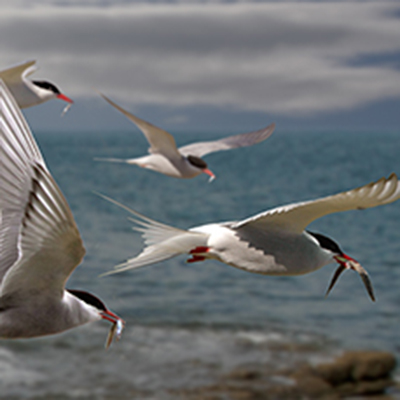
Climate change has been affecting ocean temperatures and shifting distributions of many marine species in the mid-Atlantic and New England Outer Continental Shelves, and now offshore wind development will be adding new habitats into this already uncertain picture. Offshore structures can create habitat for fish, which could benefit particular species, but they also can attract new species to these locations and change marine communities.
Marine food webs are complex and we don’t yet understand trophic dynamics well enough to predict perturbations to these systems. Trophic relationships can be documented by short-term changes in species’ behavior, co-occurrence, or long-term trends.
By understanding the mechanisms and the spatiotemporal scale of trophic relationships in this ecosystem, we can begin to understand how different kinds of change will ripple through the food web.
Observing Predators and Prey in a Dynamic Environment
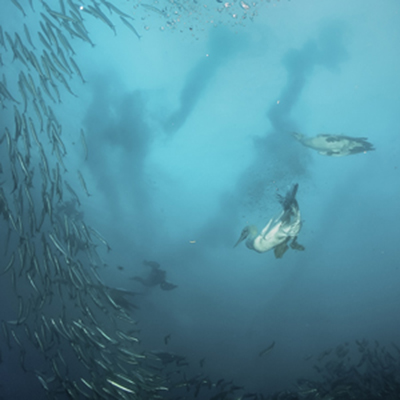
Studying trophic relationships in the marine environment is particularly difficult due to the remote and variable natures of these ecosystems. Different tools are often needed to describe patterns in predators and prey. In order to better understand how prey availability influences predator behavior, distributions, and long-term trends, this study includes:
- Compiling digital aerial survey data of forage fish shoals in the Mid-Atlantic and New York Bight to understand the oceanographic factors that lead to forage fish shoals
- Using satellite telemetry data to describe the movements of Northern Gannets, Red-throated Loons, and Long-tailed Ducks and determine how forage fish availability influences movement behavior
- Combining aerial survey data for forage fish and seabirds to determine how shifts in forage fish distributions contribute to predator distributions
- Quantifying decadal trends in forage fish distribution and predator distributions to determine how climate and other habitat changes have affected long-term trophic relationships
Innovative Wildlife Science: Applying New Technology to Track Forage Fish Shoals
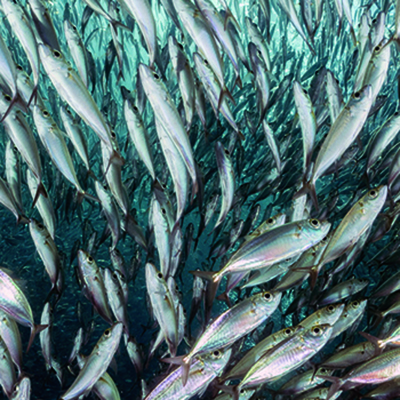
The advent of high-quality digital imagery has transformed the way that marine environments are monitored. Digital aerial survey methods can fly higher, count groups more effectively, and provide a long-term record of the survey observations. Fish shoals—large aggregations of forage fish at the water’s surface—can be detected more frequently using digital surveys than other methods, and represent an opportunity to learn more about a species group that we often lack information. These data allow us to describe distributions of forage fish and the locations they tend to aggregate—something that has not been previously been possible.
But there is a problem, we can’t identify the species of fish in these shoals because the individual fish are too small. This is where the work of our collaborators come into the picture.
Collaborations Across the Food Web: Resolving the Limitations of Digital Aerial Surveys
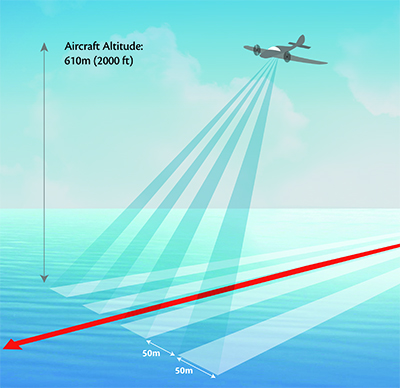
Dr. Kevin Friedland, our collaborator from NOAA, has been trying to understand forage fish on the Atlantic Outer Continental Shelf for years. While we survey from the air, Dr. Friedland has the ability to look below the surface using bottom trawl surveys that directly sample the fish. Using this technique, Dr. Friedland has been describing the distributions of forage fish, providing species-level information on what habitats forage fish use and how those patterns are changing over time. However, these surveys don’t happen often and don’t capture changes within seasons – something that is needed to understand the availability of forage fish to marine predators like seabirds.
By combining digital aerial survey data with the results of Dr. Friedland’s work, we hope to achieve a new understanding of the dynamics of forage fish distributions on the mid-Atlantic and New England Continental Shelves.
Applying Knowledge of Fish Shoals to Study Scales of Trophic Interactions Using Seabirds
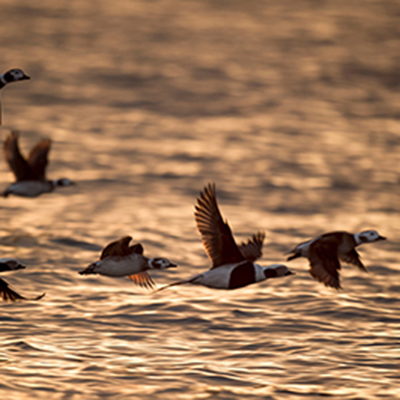
Once we better understand where forage fish shoals are and why they occur, we then can determine how they affect higher trophic level species that rely on these fish for food. While many species—including marine mammals, birds, and large fish – rely on forage fish for sustenance, our study focuses on seabirds due to prevalence of data on the distribution of species and movement of individuals. This existing information allows us to examine trophic interactions at multiple scales.
This work builds off of Dr. Holly Goyert’s research (another project collaborator at NOAA) in linking seabird density to marine community composition and uses data from the Atlantic Offshore Seabird Catalog (also managed by NOAA).
If forage fish are an important resource to a single seabird, the individual will feed in areas where there are more forage fish. If enough individuals do this, we would expect the distribution of the entire population to be linked to forage fish distributions as well. In turn, if these forage fish are so important to the population, then decades-long changes in fish populations could lead to changes in predator populations. By combining all these data to understand the mechanisms and the scale of trophic relationships in this ecosystem, we can begin to understand how different kinds of change will ripple through the food web.
Project Funding and Timeline

Funding to for this project came from the New York State Energy Research and Development Authority (NYSERDA). The project was initiated in the fall of 2019 and is expected to be completed in early 2023.


